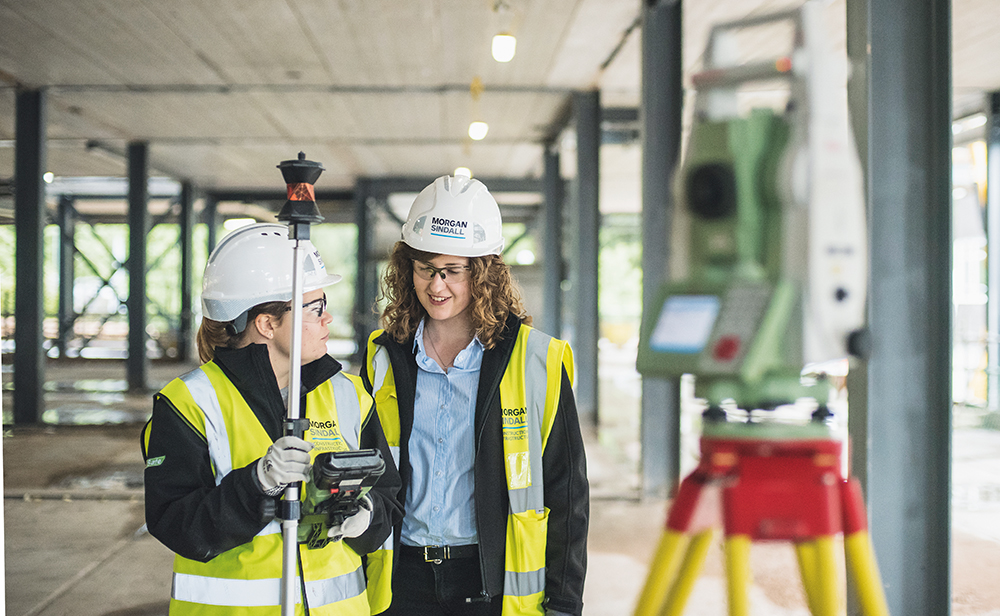
Five major contractors tell CM how they are faring when it comes to encouraging women into construction.
Galliford Try
Galliford Try saw a small improvement in the proportion of women it employs but that was offset by the acquisition of the NMCN water business last year.
The proportion of women in the group remains flat at 24%, but 41% of its graduate intake is female.
The company has focused on smart and agile working methods that allow for people from more diverse backgrounds to enter the industry.
The gender balance on its board and executive have remained the same over the past 12 months but there has been a 30% increase in female appointments at its Grade A level (senior management/regional director).
The company expects its 2021 gender pay gap figures to show an improvement. Meanwhile its early careers pay gap is actually 10.7% in favour of women.
ISG
ISG recruited 163 women last year – nearly a quarter (24%) of all of its hires over the period. Its international workforce is now 25% women, while its early careers intake (apprentices, graduates and industrial placements) last year was 37% female and 63% male – a slight improvement on 2020.
With three women and four men, its board gender split is unchanged from last year. The business expects an improvement in its gender pay gap when it reports in April.
Kier
Kier, which recently launched a drive to recruit 1,200 people, has hired 634 women over the past year at all levels, says group HR director Helen Redfern. Meanwhile, in the last two cohorts of its Raising Leaders talent programme, there has been a 50/50 split of men and women.

“We haven’t set a figure on how many women we want to join us but we are committed to attracting a diverse workforce.”
Redfern said: “We haven’t set a figure on how many women we want to join us but we are committed to attracting a diverse workforce and a key part of that is breaking down barriers to entry. As a result, we now have more part-time roles than ever before, and we offer agile working and new family-friendly policies, including a pregnancy loss policy and menopause guidance.”
Sophie Timms (corporate affairs director) and Alpna Amar (corporate development director) joined its executive committee in May 2021.
Redfern admits that Kier’s 2020 gender report, “was not where we wanted [it] to be”. But under its new Performance Centred Leadership framework everyone at Kier has open conversations with their line managers twice a year about career progression. This has resulted in 628 women being promoted over the past 12 months.
Morgan Sindall
A quarter of Morgan Sindall Group’s workforce is female. The business has launched initiatives to encourage more women into construction, including school workshops, work experience plans, apprenticeship and earn-as-you-learn schemes, and graduate programmes. The business has also developed policies to welcome women back after maternity.
The company’s board gender balance improved in 2021 as compared to 2022, following the appointment of Kathy Quashie as a non-executive director.
But the business said reducing its gender pay gap remained a “challenge” which needed longer-term solutions to encourage future managers and senior leaders to remain within the industry.
Willmott Dixon
At December 2021, 29.1% of Willmott Dixon’s workforce were women and during the past year, 46% of new recruits were women. The company is targeting gender parity across all grades by 2030.

“We have changed the wording in adverts to attract more applications from a diverse range of people.”
The company’s management trainee intake in 2021 was 49% women. Nearly half (48.5%) of all management trainees are now female, compared to 26.6% in January 2018.
Sally Cleaver, group diversity manager, said: “We have changed the wording in adverts to attract more applications from a diverse range of people, such as ‘project manager’ rather than ‘construction manager’.”
Last year saw the launch of a CITB-funded Women’s Leadership Programme. Each of the 15 women on the first cohort was assigned a mentor from Willmott Dixon’s executive leadership team, and five have now been promoted to senior positions. The company aims to support 100 women through this programme by 2030.
Willmott Dixon also expects to narrow its gender pay gap for 2021, when it is published in April.
Comments
Comments are closed.











Although policies like part time working are helpful, they figures show that generally promotions from part time contracts are less. Women undertake more roles out of work normally, covering a large amount of the chores and childcare as appose to men. Until society shifts that these roles can be undertaken 50/50 women will continue to seek lower working hours, less responsible roles and therefore gain fewer promotions. Making it more acceptable for working men to be part time, do childcare, be flexible and working targets to be realistic will do more for retaining women and encouraging growth than anything else.